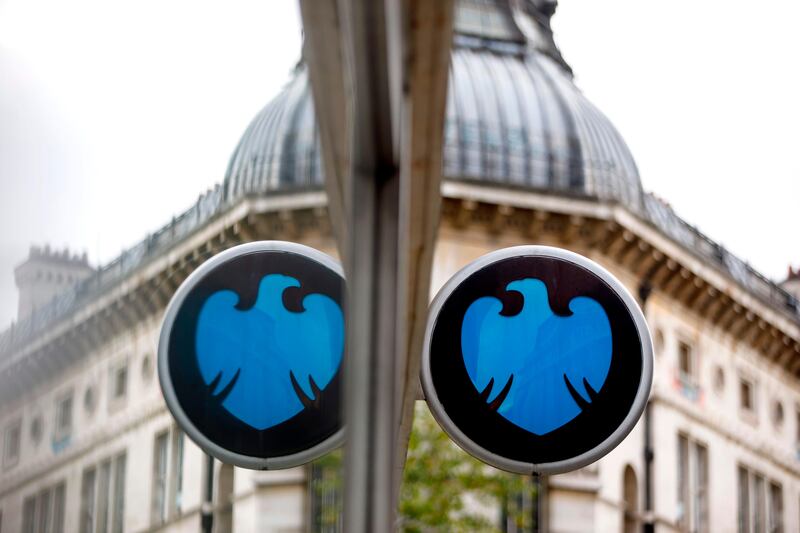Barclays bank plunged the most since the aftermath of the Brexit vote after it posted the worst markets performance in the chief executive Jes Staley’s two-year tenure.
Revenue from trading stocks, bonds and currencies fell 31 per cent in the third quarter, the lender said Thursday, trailing most Wall Street rivals that posted an average 15 per cent decline.
The stock fell as much as 7.2 per cent in London trading, wiping more than £2 billion pounds (Dh9.7bn) from the value of the company. Barclays has lost about 17 per cent this year, making it the worst performer in the Bloomberg Europe 500 Banks and Financial Services Index.
“We obviously want to see a marked improvement in all areas of the markets business,” Mr Staley said, describing the quarter as “tough” compared with US peers. “The third quarter was clearly a difficult one for us. The lack of volume and volatility hit revenues hard across the industry."
The consecutive declines in earnings will make it harder for Mr Staley to win over some investors sceptical of his strategy to build up the investment bank, which has long been Barclays’s least profitable unit. It also increases pressure on the CEO, who is under investigation by the UK’s Financial Conduct Authority for attempting to unmask a whistle-blower. Executives introduced new deadlines Thursday for improving profitability to mollify impatient investors.
Mr Staley has made building up the investment bank the centrepiece of his strategy to revive earnings at Barclays. With the division head Tim Throsby, he recently unveiled a plan to reallocate capital from low-returning lending activities to higher-risk trading desks within the division, including distressed debt and exotic products.
“We under-invested in technology and balance sheet in the markets business in the last couple of years and we need to find a better equilibrium there,” Mr Staley said in London. “We’ll get the markets business to where we want it to be.”
To give the securities unit more capital to work with, he’s sold down the bank’s African investment and European consumer networks, slashed shareholder payouts and cut loose tens of thousands of low-returning corporate clients to prioritise the world’s elite fund managers.
Equity and credit trading revenue each dropped more than 20 per cent, while rates and foreign-exchange trading, known as macro, fell 40 per cent, according to the statement. Macro was blamed for dragging down results in the first and second quarters as well, prompting Mr Throsby to reshuffle management and hire new traders to turn around the desk.
The combined 31 per cent plunge at the markets unit is the biggest since Mr Staley took over in December 2015. The next largest drop was 7 per cent in the second quarter of last year.
“There’s still a lot of heavy lifting to do” at the investment bank, Jefferies analyst Joseph Dickerson said in a note. “Fixed income represented 12 per cent of group revenue in the quarter and it will be important to get an update from management as to where the company’s strategy lies in such products.”
The return on tangible equity at the corporate and investment bank fell to 5.9 per cent from 9.2 per cent a year earlier. The same profitability measure was 18.4 per cent at the British retail and cards unit.
While Barclays’ overall pretax profit rose 32 per cent to £1.1bn, it missed the £1.4bn average estimate of 12 analysts compiled by the bank. Flattering the results, the bank did not top up its reserves for payment protection insurance compensation as it did in the same period last year.
Net operating income fell about 4 per cent to £4.5bn and the lender’s key common equity Tier 1 capital ratio was flat at 13.1 per cent.
“Barclays produced a disappointing set of results,” said Edward Firth, an analyst at Keefe, Bruyette & Woods, highlighting the lack of capital generation and impending misconduct fines. “Whilst we have been a seller this year, we had thought Barclays would struggle to disappoint low expectations. It looks like they have succeeded.”
Income at Barclays UK fell 5 per cent as both the domestic retail and credit card operations reported drops in revenue, according to the bank. Loan impairments fell 43 per cent, soothing concerns about a consumer credit bubble in the country.
Executives set new targets for costs and profitability, including a pledge to generate a return on tangible equity of greater than 9 per cent in 2019 and more than 10 per cent the following year. It is targeting costs in 2019 to be between £13.6bn and £13.9bn.
The lender also updated investors in a separate statement on its plans to create a ring-fenced retail bank, which will be called Barclays Bank UK, to comply with UK laws requiring consumers to be protected from trading losses.






